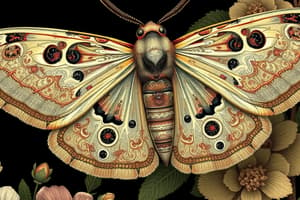Podcast
Questions and Answers
Where do peppered moths live?
Where do peppered moths live?
England, Europe, and North America
How do the moth larvae survive predators?
How do the moth larvae survive predators?
Their bodies look like sticks, which hides them and helps them survive predators.
What do the moths do during the winter?
What do the moths do during the winter?
They change into pupae (cocoons).
What color is the 'typica' version of the moths? What color is the 'carbonaria' version?
What color is the 'typica' version of the moths? What color is the 'carbonaria' version?
How do adult moths survive predation?
How do adult moths survive predation?
What was the industrial revolution?
What was the industrial revolution?
What was causing the change in the color of the moths?
What was causing the change in the color of the moths?
What is natural selection?
What is natural selection?
Why would dark moths have an advantage?
Why would dark moths have an advantage?
What is an entomologist?
What is an entomologist?
How do scientists test theories?
How do scientists test theories?
Dr. Kettlewell predicted that clean forests would have ___ colored moths, and polluted forests would have ___ colored moths.
Dr. Kettlewell predicted that clean forests would have ___ colored moths, and polluted forests would have ___ colored moths.
How did Kettlewell test his hypothesis?
How did Kettlewell test his hypothesis?
How did Kettlewell determine if moths lived longer than others?
How did Kettlewell determine if moths lived longer than others?
Explain how the color of the moths increases or decreases their chances of survival.
Explain how the color of the moths increases or decreases their chances of survival.
Explain the concept of natural selection using your moths as an example.
Explain the concept of natural selection using your moths as an example.
Predict what would happen if there were no predators in the forest. Would the moth colors have changed? Why or why not?
Predict what would happen if there were no predators in the forest. Would the moth colors have changed? Why or why not?
If pollution was reduced late in the century, what would happen to the color of the moths? Explain your answer.
If pollution was reduced late in the century, what would happen to the color of the moths? Explain your answer.
How do we know that the moths evolved?
How do we know that the moths evolved?
Flashcards are hidden until you start studying
Study Notes
Habitat and Appearance
- Peppered moths are found in England, Europe, and North America.
- Larvae mimic sticks to avoid predation, enhancing their survival chances.
- Moths enter a pupal stage (cocoon) during winter.
Color Variants
- "Typica" version is light-colored, while "carbonaria" version is dark, almost black.
- The color differences in moths are influenced by genetic mutations.
Behavior and Survival
- Adult moths are nocturnal, resting during the day to avoid predators, with added camouflage for protection.
- The Industrial Revolution introduced coal-burning factories, resulting in dark smoke that polluted environments.
Natural Selection
- Natural selection leads to species adaptation through variations that allow some individuals to survive and reproduce more effectively.
- Dark moths have a survival advantage in dark forests due to better camouflage.
Scientific Methodology
- Entomologists study insects, including peppered moths, to understand their behaviors and adaptations.
- Scientists test hypotheses by making predictions and observing if outcomes match expectations.
Kettlewell's Experiments
- Dr. Kettlewell predicted that light-colored moths would thrive in clean forests, while dark moths would prosper in polluted ones.
- He placed light and dark moths on tree trunks, tracking their predation by birds to test his hypothesis.
- Data collection involved observing survival rates of moths in various forest conditions.
Survival Mechanisms
- In light forests, light moths are favored due to superior camouflage compared to dark moths, and vice versa in dark forests.
- Coloration directly impacts survival chances based on environmental conditions.
Evolutionary Implications
- Natural selection explains how successful traits, like camouflage, are passed down through generations in moth populations.
- In a predator-free environment, there would be little evolutionary pressure for color change in moths.
Impact of Pollution
- Reducing pollution near factories would likely lead to an increase in light-colored moth populations as clean forests would favor their camouflage.
Evidence of Evolution
- Moths have evolved from light-colored to dark-colored due to mutations that provided better survival in changing environments, exemplifying the process of evolution.
Studying That Suits You
Use AI to generate personalized quizzes and flashcards to suit your learning preferences.




